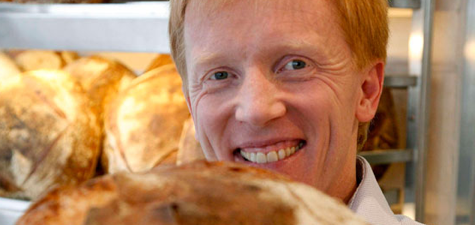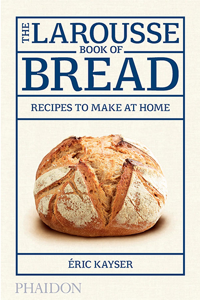
If you are going to make bread at home – and you should – make the best bread you can.
How?
By following the advice and instructions of Eric Kayser in The Larousse Book of Bread: Recipes to Make at Home (Phaidon 2015). You should have the Larousse Gastronomique. Get this book to make bread at home your summer resolution.
 Don’t skip Eric’s essay, For the Love of Bread. In fact, share it with your kids or your friends’ kids. It’s about the system of apprenticeship and service that is part of the French system:
Don’t skip Eric’s essay, For the Love of Bread. In fact, share it with your kids or your friends’ kids. It’s about the system of apprenticeship and service that is part of the French system:
On returning to France, I joined the Compagnons du Devoir (“Companions of Duty”), a workers’ association that offered apprentices opportunities to further their training and travel. The chance to gain practical knowledge while traveling appealed to me…My own experiences instilled in me a desire to help prevent apprentices going astray in the world, to teach them how to respect others and to earn respect themselves. (pp. 10-11)
Who said cookbooks were only about cooking?
This is a step-by-step book to make artisanal bread. Eric instructs the reader on choosing the best kind of flour and other ingredients, equipment, and then shows how to knead dough with the help of some clear photographs of wet and dry dough kneading by Massimo Pessina. But it is the fermentation process that gets the most attention. He includes the French words for the different stages of fermentation, so that you’ll be a step ahead if you end up as a stagier in a boulangerie in France! There is an especially good section on Learning from Mistakes: ” The potential for error will be different every time you bake, since the dough itself is never exactly the same. It’s up to you to analyze each challenge that arises.” (p. 44) The list of problems each has more than one reason, and often five or six.
The recipes are divided up, with chapters on Traditional Breads, Specialty Breads, followed by Organic Naturally Leavened Breads and more. Each recipe has accompanying photographs showing the dough and bread at different stages. The first recipe for a Boule (pp. 48-9) will teach you the basic technique, and then the following recipes are largely changing the shape and the scoring the loaves. If you move on to the next chapter, Eric will show you how to add rye for First Mill Loaf (pp. 94-5) or seeds to the Mixed Seed Bread (pp. 98-9). There is even a recipe for Bagels (pp. 138-9) albeit very French bagels. For those looking for gluten-free recipes, Eric includes two: Gluten-Free Corn Bread (pp. 120-1) and Gluten-Free Chestnut Flour Bread (pp. 122-3), which includes only soy flour, chestnut flour, salt, water, and yeast.
The magic of yeast and flour and water is seductive and addictive – not just the eating, but also the actual making. Eric Kayser is an excellent teacher and this book will help novices and those who have already caught the bread-making bug, continue on their education. Great bread requires great ingredients, attention, and persistence – all good things to acquire.
